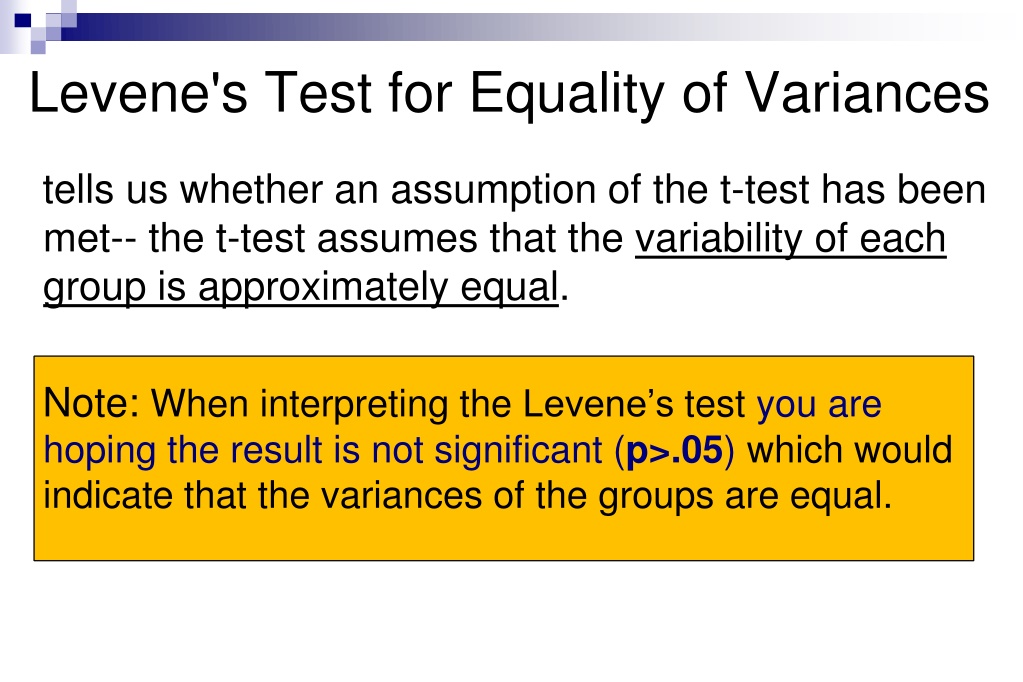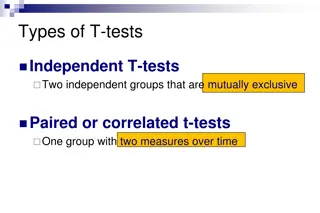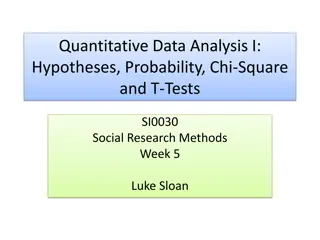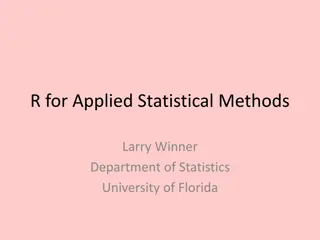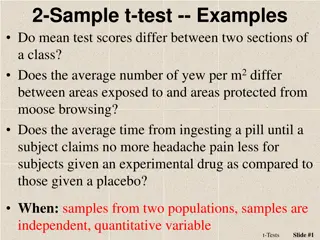Understanding Statistical Tests: Levene's Test vs. T-Test
Levene's test for equality of variances helps determine if the assumption of equal group variability in a t-test is met. When the result is not significant (p > 0.05), it indicates equal variances. Conversely, the t-test assesses differences between group means. Two examples are provided: one with SDAT scores showing no significant difference between experimental and control groups, and another with temperature measurements pre and post aspirin intake indicating a significant difference.
Download Presentation

Please find below an Image/Link to download the presentation.
The content on the website is provided AS IS for your information and personal use only. It may not be sold, licensed, or shared on other websites without obtaining consent from the author. Download presentation by click this link. If you encounter any issues during the download, it is possible that the publisher has removed the file from their server.
E N D
Presentation Transcript
Levene's Test for Equality of Variances tells us whether an assumption of the t-test has been met-- the t-test assumes that the variability of each group is approximately equal. Note: When interpreting the Levene s test you are hoping the result is not significant (p>.05) which would indicate that the variances of the groups are equal.
If this value is less than or equal to your level for the test (usually .05), then you can reject the null hypothesis that the variability of the two groups is equal, implying that the variances are unequal. If the p value is less than or equal to the level, then you should use the bottom row of the output (the row labeled "Equal variances not assumed.") If the p value is greater than your level, then you should use the middle row of the output (the row labeled "Equal variances assumed.") In this example, .203 is larger than of .05, so we will assume that the variances are equal and we will use the middle row of the output.
SDAT Scores t-Test results n 10 10 Mean 95.00 105.00 Std Dev 12.43 11.78 T df 18 p Experimental Control -1.84 0.081 Levene s test=.719 OUTPUT What to look for: 1.group statistics. We see that the mean SDAT score for the experimental group is 95.00 (SD 12.43) and for the control group the mean is105.00 (SD 11.78). 2. Levene s test result. The result is .719 which is not significant because p>.05 so we can assume that there is no significant difference between the variances of the two groups. 3.T statistic which is a -1.84, disregard the negative sign in front of the value. The negative sign is there because of the way the variables were entered into the computer program. 4.The df (degrees of freedom) are 18. This is calculated by subtracting one degree of freedom from the n of each group (experimental group 10-1 = 9, control 10-1 = 9) and then adding the result (9 + 9 = 18). Finally, with alpha set at .05, we conclude that p=.081 is not statistically significant (p>.05) and therefore that there is not a statistically significant difference between the mean SDAT scores of the experimental and control group.
Temperature t-Test results n Mean Std Dev T df p Before 12 102.20 0.80 6.98 11 0.000 After 12 100.45 0.56 The above table contains statistics for a paired sample. There are 12 patients in the sample and based on these results all 12 patients participated at both time periods. 1. The mean temperature before administration of aspirin was 102.20 (SD 0.80) and the mean temperature 1 hour after aspirin was 100.45 (SD 0.56). 2. The Levene s test is not necessary here because we are measuring the same people at two different times so the variances between the groups would be equal since they are coming from the same population. 3. Next look at the value of the paired samples test, t=6.98, df=11, p=.000 and determine that the p-value is significant since the actual probability of this result p<.001 that is <.05. 4. Thus, the null hypothesis is rejected and the research hypothesis is supported. Therefore, we conclude that there is a statistically significant difference between mean temperatures taken before and one hour after taking aspirin.
